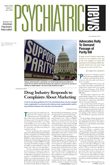“The annual meeting is visibly different in today’s environment. Pharmaceutical logos seem to be everywhere. The exhibit hall is usually centrally located and huge, with gigantic display booths crammed not only with product information but also with interactive computer programs, mini-lectures by experts (either live or recorded), food, and a wealth of takeaway items.”
For anyone who has been to a recent APA annual meeting, the description might sound familiar. In actuality, this excerpt is from an editorial in a recent issue of the journal Neurology, depicting the scene at the annual meetings of the American Academy of Neurology (AAN). Though readers of recent articles in the Washington Post and the Boston Globe critiquing the pharmaceutical presence at this year’s APA meeting in Philadelphia might have assumed that this phenomenon was unique to psychiatry, the Neurology editorial makes it clear that the influence of the pharmaceutical industry is something with which all of medicine must cope.
Sometimes members ask why APA has any relationship with the major pharmaceutical companies. The answer for us, as for AAN and other medical groups, is that the industry provides APA with funding for key projects that are of value to our members, as well as unrestricted support for other activities. Scores of residents, for example, are chosen each year to attend APA meetings and to participate in component activities as part of fellowship programs funded by the pharmaceutical industry. Although the companies provide financial support, the recipients are chosen by APA committees entirely independent of any industry input. Similarly, member newsletters such as the ones APA produces on managed care and on research are published with industry support, but without control of content.
Industry-sponsored symposia (ISS)—often highly touted and featuring some of the biggest names in psychiatry—are a prominent part of the annual meeting program. Pharmaceutical companies pay APA a fee to obtain one of a limited number of slots for such programs and then spend many times that amount to produce and promote them. Doesn’t having these symposia on the program compromise the scientific integrity of the meeting? Although you wouldn’t have known it from reading the Post or the Globe, protecting the integrity of the information to which attendees at the meeting are exposed is precisely why these events are on the program.
Were we to expel ISS sessions from our meeting, the pharmaceutical companies would hold them anyway, concurrent with our sessions and at nearby hotels. In this scenario, which is acted out at the meetings of other medical organizations, we would have absolutely no control over the material presented. By incorporating these symposia into the scientific program, as we do, we can take steps to ensure the objectivity of the sessions. Proposals for ISS sessions are developed by APA members, and they are submitted to and reviewed by members of the APA Scientific Program Committee. Those that pass muster are presented to the companies for support.
Of course, the companies are largely interested in sponsoring programs that highlight pharmacologic treatments. But in recent years, with encouragement from APA, support has been obtained for programs dealing with such topics as the ethics of psychiatric research and psychosocial approaches to the rehabilitation of persons with serious mental illnesses. APA has also been able to encourage the symposia organizers to include a wider diversity of presenters. An APA committee representative sits in on every ISS session to monitor for bias in the presentations (for example, overtly promoting the sponsor’s product), and subcommittee members listen to tapes of the sessions after the fact. Evidence of bias can lead to exclusion from subsequent APA annual meeting presentations.
What about those elaborate pavilions on the exhibit floor, where pharmaceutical companies give away all sorts of trinkets? My problem is not with the companies—marketing being the quintessential capitalist exercise—but with the behavior of some of our colleagues. Are there any psychiatrists in America who can’t afford to buy their own pens, notepads, and frisbees or to call home from the annual meeting on their own dime? What other than a feeding frenzy can explain the shopping bags crammed with giveaways that some attendees can be seen lugging from the convention center? (Do they really send their kids to the park to play with frisbees emblazoned with the name of a popular SSRI?) I don’t blame the companies for trying to foist this stuff on us; I blame us for taking it.
Imagine what would happen if we—all of us—suddenly stopped clamoring for logoed paperweights and calendars. Picture the consequences of our approaching the pharmaceutical displays and asking for reprints of controlled studies from peer-reviewed journals demonstrating the efficacy of the product being hawked and comparing it with alternatives (especially less expensive ones) on the market. Within a year, the nature of the handouts would change from squeezable tension relievers shaped like the human brain to compilations of published studies and other educational information. And it’s all in our hands.
Are there risks attendant to the pharmaceutical presence at our meetings? Without question. Moreover, the risks mutate over time. Last year, the Scientific Program Committee noticed that some poster presentations were being made by pharmaceutical company representatives rather than the researchers and that reps were present to distribute marketing information. In response, this year reps were barred from the poster areas. Should we simply toss the industry out of our meetings? I think we would lose more than we would gain by doing so. Rather, I think the AAN Board of Directors got it right when it said:
“We value the relationship the AAN has had with industry, but the corporate role needs to be continually defined and monitored. When violations occur, they must be dealt with promptly and decisively with imposed penalties that are proportional to the infractions. Appropriate guidelines are an essential component of managing this relationship, if we are to maintain our integrity as an organization and the confidence of the public in the medical profession.” ▪

